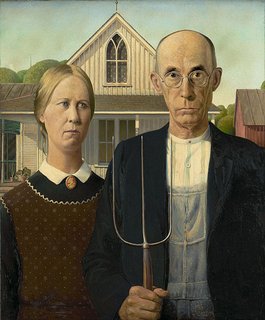The (still? When is the transfer?) publisher of the Chicago Sun-Times, Fields Company, once owned Muzak (1986-2011).
those are cartoonists, if I recall. Sure, a kind of art, but you can’t easily compare them directly to fine art painters. Anyway I think the reason people were originally drawn to Grant Wood’s paintings (although now American Gothic is as iconified as Superman, it’s not art any more) is because it told a layered truth about the rural Midwest of his day that people recognized. The dour, steadfast, plain, hard working qualities that were familiar to many, along with a commentary about the loneliness and silence that went with it. People want art that resonates with them – clearly that work doesn’t with you. But it does or did for millions.
Sure, cartoons are a kind of art, but you can’t easily compare them directly to fine art painters. Anyway I think the reason people were originally drawn to Grant Wood’s paintings (although now American Gothic is as iconified as Superman, it’s not art any more) is because it told a layered truth about the rural Midwest of his day that people recognized. The dour, steadfast, plain, hard working qualities that were familiar to many, along with a commentary about the loneliness and silence that went with it. People want art that resonates with them – clearly that work doesn’t with you. But it does or did for millions.
(A little bit NSFW)
B. Kliban
Well, that’s just one interpretation. There are dozens of others.
Note the word ‘Gothic’ and the Gothic window behind them. The woman’s brooch of Proserpine – a goddess of the underworld, abducted by Hades or Pluto – and her loose strand of hair, similar to the loose strand of hair on the brooch. It’s been suggested that the ball on the weathervane at the top of the picture may be a reference to the planet Pluto, recently discovered at the time of the painting.
The pitchfork has long been associated with with the devil and hell, and with puritanical and peasant violence. Note the dour, cold, impersonal, aggressive, judgemental looks.
You could just as easily take it as a bitter satire on the Midwest American rural population.
That’s a different meaning of cartoon.
I just want to loop back to say, that’s the sort of thing that I love about this thread.
Thanks.
j
Well, the Greek references are quite a stretch, in my opinion. The hostility is clearly there, although whether it is in the pitchfork, the figures, or the viewer’s gaze, is more unclear. It’s a painting with layers of meaning, which is a reason why it continues to be of interest.
George Herriman is accepted into the lofty Parnassus of Fine Art. Later artists-artists who used cartoonism as a visual lexicon were Öyvind Fahlström and HC Westerman (not to mention the Pop artists like Lichtenstein and Warhol). Phillip Guston arguably improved when he discarded Abstract Expressionism for cartoons in oil.
But yes, Grant Wood was to American painting what Sinclair Lewis was to literature. And their Midwest is still there.
I’ve probably butchered the story but it’s told very well in ep2 of The Disappearing Spoon podcast:
I have that book! And the story is great indeed (though I did not remember it from the book).
George Herriman…
I’d certainly call Offisa Pup a sad sack.
Well, the Greek references are quite a stretch, in my opinion. The hostility is clearly there, although whether it is in the pitchfork, the figures, or the viewer’s gaze, is more unclear. It’s a painting with layers of meaning, which is a reason why it continues to be of interest.
There are dozens of interpretations of American Gothic, but that one makes the most sense to me. The details of the painting are there for a reason. They are not random. Grant Wood was greatly influenced by the Flemish school of art, where details matter.
Another detail that I didn’t mention earlier is that the curtains of the window are drawn in the daytime, a convention indicating that someone has died.
I think there was a concerted effort to find some positive view of of the painting, and I think the artist backtracked a bit because he didn’t want to become a target for hatred… but even the most superficial glance at the work will tell you that those people are NOT depicted in a positive light. This is NOT an affectionate depiction of ‘plain, hardworking people’.
The term Gothic evokes Gothic horror fiction among other things, and is always associated with anti-rationalism. It certainly wasn’t a positive term in the 1930s.
(Sorry to interrupt your discussion. But I had to add this one…)
Honey is just basically bee vomit.
(As I said, I couldn’t wait to add that one. Now carry on, where you were before ![]()
![]() .)
.)
On that tack, alcohol is basically yeast … something.
As yeast cells don’t have a digestive tract then it’s not flatuation/eructation/ emesis/urination so let’s settle on, uummm, perspiration.
As you were.
Also I read somewhere, possibly in one of Cecil Adams’ books ironically, that breasts are basically just specialized sweat glands. So I guess milk is just a glass of sweat. (Still sounds better to me than Dr. Pepper ![]()
![]() .)
.)
Actually, a breast is an exocrine gland, as is a sweat gland.
A gland that makes substances such as sweat, tears, saliva, milk, and digestive juices, and releases them through a duct or opening to a body surface. Examples of exocrine glands include sweat glands, lacrimal glands, salivary glands, mammary glands, and digestive glands in the stomach, pancreas, and intestines .
[image]
https://www.cancer.gov › def › exoc…
Definition of exocrine gland - NCI Dictionary of Cancer Terms
Some people assume that everyone in South America just speaks Spanish.
Actually in Brazil they speak Portuguese.
(Question: just how closely are the two languages related? I mean, are they mutually-intelligible, so to speak?)

